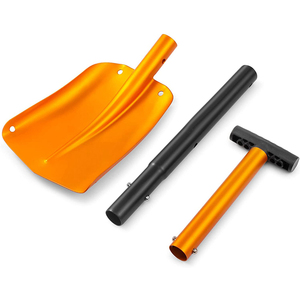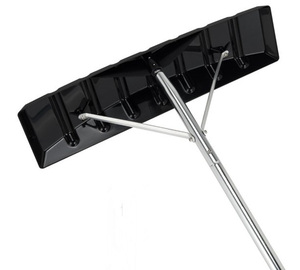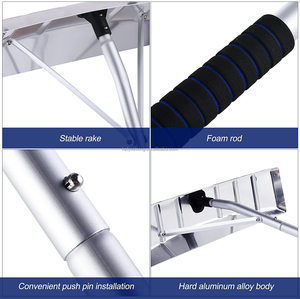(54 products available)







































































































































































































The following are the most common types of avalanche shovels:
Most manufacturers make collapsible avalanche shovels with folding or telescoping blades. These products are known for their compactity; hence, they are often carried in backpacks. In particular, collapsible shovels are ideal for avalanche rescuers because they are lightweight and easy to store. Normally, these shovels come designed with a strong and durable metal or plastic, but the collapsible features slightly weaken the structure. Nevertheless, the shovels are still good enough for carrying out simple tasks, such as digging through snow.
These shovels are large and conventional, without any collapsing mechanisms. These full-sized avalanche shovels provide better digging and moving capabilities because of their larger blades and handles. Although these shovels are heavy and difficult to transport, they are better used in areas prone to avalanche snowfall.
These shovels are designed with both hiking staff and shovels, offering users the best of both worlds. The handle can be adjusted to act as a trekking pole, while the shovel head is attached to the bottom. Such shovels are versatile for those going on long journeys, as they can switch from walking to shoveling with ease.
Manufacturers make mini shovels small and compact for use in emergencies, which do not require a full-sized shovel. In most cases, these shovels measure approximately two feet or one foot in length. They are suited for small-scale digging or clearing tasks. Shovels of mini size are often found in cars, small kits, or in construction industry personnel's bags for brief clearing needs.
Backcountry skiers use these shovels as a precautionary tool when they hike in ski areas without marked trails. Also, snowshoers, cross-country skiers, and winter hikers, particularly those who explore remote mountainous landscapes, include avalanche shovels in their backcountry survival kits. In most cases, these users face similar risks of avalanche burial, so they carry the right tools to ensure their safety.
Avalanche shovels are also commonly used by professional search and rescue teams in regions that face avalanche hazards. They assist in locating and recovering buried victims. Together with probes and other equipment, these shovels help rescues to be more effective in carrying out their work. In most cases, the teams conduct operations in areas with avalanche risks, and possessing quality shovels is crucial.
Avalanche control agencies and companies that perform avalanche mitigation work use these shovels on a large scale. At these places, the shovels assist in excavation, lateral transport, and installation of support structures in potentially avalanche-prone areas. These can be manual excavations in small-scale operations or large-scale mechanical excavation for major projects.
Avalanche shovels are useful in construction-related applications where snow removal is necessary for worker safety and continued project progress. Anyone working in construction should always be ready to handle avalanches or any other extreme weather conditions that could interfere with their projects.
Mining companies operating in mountainous areas are at risk of avalanches. Any accumulation of snow on open pits or unstable mountain walls can lead to a high probability of avalanches. Therefore, personnel working on mining and energy infrastructure is advised to carry avalanche shovels for safety purposes.
Blade material
Most avalanche shovels have steel or aluminum blades since they are the preferred choices for handling heavy workload tasks, such as those related to snow. They withstand pressure and do not bend easily. For people who need something lighter, they should opt for either plastic or composite material, as these options are lighter, although not as tough as metal.
Handles
In most cases, avalanche shovels' handles are made using either aluminum or a strong plastic. Note that an ergonomic D-shaped or T-shaped handle guarantees a better grip when conditions get wet or icy. Hence, users can shovel with less strain and faster motion.
Blade size
Selection of the proper size of the shovel blade for an avalanche shovel is fundamental since it affects efficiency. In general, larger blades offer higher capacity for heavy-duty conditions, while smaller ones are manageable in tight spaces. Choose wisely depending on the potential circumstances likely to be faced in the field.
Weight
The weight of an avalanche shovel greatly influences portability. The lighter the shovel, the easier it becomes to carry with minimal fatigue. Conversely, light products may not be as powerful as the heavy ones. It's advisable to find a good balance between weight and functionality according to the desired workload.
Avalanche safety shovels
are devastatingly life-saving tools in emergency scenarios. Ideally, when an avalanche catches people, they have to stay calm. Panic only worsens the situation because they could bury themselves even deeper. Secondly, they have to create an air pocket around their face so that they have enough oxygen as they wait for help. Thirdly, it's advisable to dig sideways or at an angle rather than straight up and down so that they don't use extra energy. If they are digging up, they're also hurting their own chances of survival because they are digging toward the snow rather than away from it. The last thing people should do while waiting is making noise and signaling with whistles or mirrors if they have them.Post-season care
Store the shovel in a cool, dry area after the snow has melted. This reduces wear on components caused by long exposure to moisture and elements.
Material care
Destructive conditions such as rust or bend marks on steel or aluminum blades can affect the performance of avalanche shovels. Luckily, the use of metal polishes and repair mats can eliminate these problems. Avoid plastic blades being exposed to sunny conditions for long hours.
Check for cracks
Snow gettng attached on the shovel can lateron turn into moisture, which causes cracks. Note that plastic or composite blades are often vulnerable to cracking. Conduct a thorough inspection after the shovels have been used for some time.
Handles repairs
Loose handles are common due to frequent use. Tighten them using appropriate screws. If they are broken, consider replacing the handle with one that suits the users' needs the most.
The manufacturers make the best snow shovels for avalanches from high-quality materials such as aircraft-grade aluminum, steel, or high-strength plastic. Note that while aluminum is lightweight, high-grade aluminum is stronger and more durable. As for steel, it provides unparalleled strength and rigidity for the toughest tasks, although it is heavier. Plastic, on the other hand, is lightweight and resistant to rust, but not as strong as metal. This is why it is recommended to check the material carefully before purchasing an avalanche shovel.
A premium avalanche shovel's blade features welds or rivets reinforcing the blade and handle connection along with tight seams. Cheap alternatives may have weak soldering or no reinforcements, risking failure during heavy workloads.
Not all shovels come with safety features, while some manufacturers always add extra safety features such as blade guards to protect the user from accidental cuts during transport. Some shovels have D-shaped grips designed to prevent the user's hand from slipping. These grips also add comfort during use.
It's a must for everyone to have a proper instruction manual that contains relevant information such as do's and don'ts, maintenance, warranty, and safety precautions. This decreases the chances of misuse or damage.
Many manufacturers use thin materials on the blade to reduce cost. Though they are lightweight, such blades tend to bend or break under immense pressure. Therefore, it's advisable for buyers to avoid shovels with thin blade materials, particularly in their business, as this might lead to carrying so many items that can affect productivity.
Corrosion on avalanche shovels is a common problem, especially for those used in coastal regions. Therefore, it's important to consider shovels that are either rust-resistant or treated with corrosion inhibitors for those who operate near salty air or moisture conditions.
A1. Buyers need to consider the handle, material, size, and weight of the shovel pike when selecting the right shovel for avalanches. These features are durable enough to face the harsh conditions of avalanches while maintaining efficiency. Therefore, selecting a well-constructed shovel with the right specifications is critical for effectively facing avalanche conditions.
A2. Manufacturers make these shovels from aluminum, steel, or reinforced plastic. Each material has its own unique benefits. Ideally, aluminum strikes the right balance between strength and weight, while steel proves itself as the strongest but the heaviest. Plastic is lightweight and rust-resistant but lacks durability compared to metals.
A3. No specific standards exist for these shovels, but several derivatives conform to guidelines by backcountry skiing organizations. It's advisable that buyers research and refer to recommendations from reputable sources within this niche.
A4. For longevity, users need to wash their shovels using mild soap and water in order to minimize corrosion and wear clean them after use. Also, proper storage and maintenance (such as lubricating metal parts) will help maintain the tools and extend their lifespan.
A5. Manufacturers incorporate distinctive design elements and advanced materials into their shovels to make them stand out. They use lightweight yet tough materials, ergonomic handles, and markings for increasing visibility in the snow.